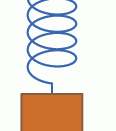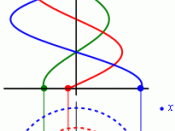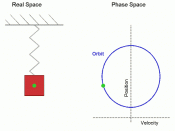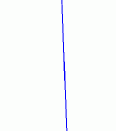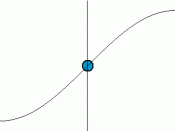IntroductionThis experiment is based on the natural facts that the metallic things get extension to certain limit depending upon their force constant. The metallic bridge is constructed in such a way that they get extended to certain limit depending upon the traffic that passes through. It is the real matter that harbour bridge also get extension upto 21 cms. Same like in spring balance, the measurement it can measured upto is written in it to ensure that we canÃÂt measure accurately more than the limit specified as it also suffer from extensions above the limit.
To avoid these problems, and to determine the force limit, Scientist named Hooke invented the theory, which is called HookeÃÂs Law.
HookeÃÂs law states that the extension produced on a vibrating string is directly proportional to the force applied. If a force F is applied to a string, the spring is extended by a length y,i.e
F= ky where k is constant known as the force constant, spring constant or stiffness factor. Its unit is Newton per meter.
The force for the suspended wire depends on the acceleration due to gravity(g), and the mass of metal blocks,i.e. F= Mg where M is mass in Kg.
Force is calculated by hanging the known mass M to the end of the vertically hanged string. The graph is plotted for force against the extension, and slope is determined, which is the value of constant, k.
HookeÃÂs law also states, the time taken by the vibrating spring in harmonic motion is directly proportional to the mass of metal blocks hanged. If a body of mass M is hanged on the end of the spring and is set to oscillate in simple harmonic motion, the time period T is given by;T=2ÃÂ , where k is spring constant.
Materials RequiredFollowing are the apparatus required for the measurement of extension of a spring in relation with force exerted and the period of a spring oscillator.
ÃÂMeter rulerÃÂStopwatchÃÂSpringÃÂBrass collar and pinÃÂSet masses on carrierÃÂRetort standÃÂClampsÃÂBoss headsFig1: Figure showing the spring wire, attached at fixed point, with mass blocks at the end of the wire, and the extension produced in addition of mass.
ProcedureFirst of all, all the apparatus were set up. The metal stand with clamps was attached with meter scale ruler. The spring was suspended in the clamps vertically near the meter scale so that the reading of length of spring can be measured on the same time. Then, the mass was suspended at the end of the string, which produced certain extension on the wire. In this process, the masses were loaded carefully and wasnÃÂt loaded more than the limitations of the wire. The extension reading was noted from the meter scale, and again load was increased in steps, corresponding value of extension was noted for each value of masses. All of these readings were recorded in the table, and the mass was converted into Newton by using g=9.8m .
ResultsBelow is the table showing all the readings of mass and the corresponding extension in metres.
Mass(g)Stretched Spring Length(cm)Mass(kg)Stretched Spring Length(m)Force(N)00000502.10.050.0210.491005.90.10.0590.9815010.10.150.1011.4720013.70.20.1371.9625017.50.250.1752.4530021.60.30.2162.9435025.50.350.2553.4340029.20.40.2923.92Fig: table showing the measurement of length of extension with different masses.
In the observations, we found that increase in masses changed the extension produced. At Mass, M= 0kg, Stretched length is 0m as no force is applied on the spring. When the spring is hanged with 0.05kg mass, it produces extension of 0.021m. Again, when mass is added to 0.1kg, the spring produces more extension than before, i.e it extended 0.059m. The spring gets extended upto its elasticity limit.
A graph is constructed with force on X-axis and Stretched length in Y-axis. With the data above, we found a straight line.
Fig. Graph of applied force with different masses with corresponding extension length.
In the above graph, we found that the stretched length increases with increase in Force applied.
From the graph, we get a straight line. Now, taking the slope pf the graph, we get,K=(3.43-0.98)/(0.255-0.059) [m=(y2-y1)/(x2-1)]= 12.5 Newton per meter.
Hence, we get spring constant to be 12.5 Newton per meter.
Now, for second set of experiment, half the weight from the spring was taken out to avoid accidents with bossheads. Then, the masses hanged with spring was pulled down and was let to oscillate in simple harmonic motion. On the same time, time was recorded for complete 10 oscillations with the help of stop watch. The mass was 0.2 kg for the oscillationIn this observation, we gotTime taken for 10 Oscillation(t)=8.25 secondsi.e time for 1 oscillation(T)=8.25/10=0.825 seconds.
From HookeÃÂs Law,T=2i.e k=(M*42)/T2K= (0.2*4*3.14*3.14)/(0.825*0.825)k=11.60 kg per second squareAnalysis:From the two set of experiment, we determined the value of spring constant, k. The value comes slightly different because of experimental errors. The errors can be in the measurement of length of extension of the spring in first set of experiment,or can be in noticing the exact time for 10 oscillation in simple harmonic motion. The motion wonÃÂt be perfect harmonic motion if the slots werenÃÂt pulled exact vertical with the surface.In first set of experiment, we found the value of spring constant to be 12.5 Newton per meter while in second set of experiment, we found the constant equals to 11.60 kg per second square. From these two results , we can make an analysis that, the value of spring constant is in between 12.5 and 11.6, probably 12.05 meter per second or 12.05kg per second square.
Conclusion:From this experiment, we found the relationship between the extension of a spring and the force exerted on the spring, and we also determined the period of the spring oscillator. With this value of time of oscillation, we determined the spring constant, and we compare this value with the value of slope of the graph which was plotted for Force versus the extension produced. We, now can conclude that the extension produced on the spring is directly proportional to the force applied, and the time taken by the spring is directly proportional to the mass used for the particular type of spring.
Hence, we verified the HookeÃÂs Law for a vibrating spring oscillating in simple harmonic motion.
Reference:Physics I, Insearch Academic, UTS Insearch, Pg.32-34
